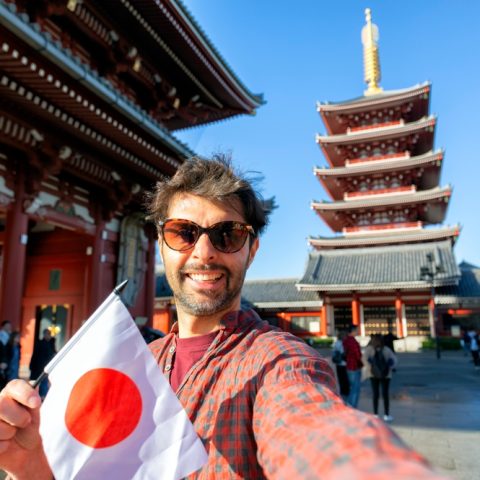
It’s summertime in Japan, and while most people worry about the soaring temperatures, there are a lot of amazing reasons why we need to enjoy summer to the fullest.
Wondering what things to do while in Japan? We’ve rounded up ten unique and fun summer activities for everyone to enjoy.

Photo by Finn on Unsplash
1. Explore a Japanese beach.
Japan is an island nation filled with beautiful beaches. If you happen to stay in Tokyo and don’t have time to travel far away, the beaches in Kanagawa prefecture are the favorite spots among city dwellers.
Zushi Beach is Tokyo’s closest natural beach, perfect for watersports, watching sunsets, and viewing the majestic Mt. Fuji! For foodies, you can explore the nearby cafes and restaurants for a great meal.
Meanwhile, the beaches in Okinawa prefecture are famous for their clear turquoise waters and white sand beaches. Because of its tropical climate, the area offers the longest beach season in Japan.

Photo Source: Christina Oshima
2. Try your hand at Yana fishing
Explore the rivers of rural Japan and catch an ayu (sweetfish) literally with your bare hands! Yes, not kidding here, but the yana fishing method is an ancient and unique way of catching a fish.
Yana acts like a fish trap made of bamboo reeds that are thatched together to create a platform stretched across the river. For those who love to participate in this activity, visitors are guided to stand on the yana platform while the river rushes through it. Ayu is released upstream with the water and they swim downward,s where they become caught in the bamboo thatching. Visitors then rush to catch the ayu with their bare hands.

Photo Source: Christina Oshima
Most yana fishing sites have restaurants that offer to grill the caught ayu. Customers have the option to dine in or just catch and release the ayu for a fun experience. Tochigi, Gunma, Gifu, and Aichi prefectures have dozens of locations to try yana fishing amidst beautiful natural surroundings.

Image by Tuan Hung Nguyen from Pixabay
3. Marvel at the fireworks display
Japan’s cities and towns host an annual fireworks festival in summer, around the month of July to August. This magical event is much-awaited by both locals and foreign tourists alike. A spectacular display of fireworks will light up the summer sky for about two hours.
In addition to fireworks, yaitai food stalls are also lined up in the city selling mouth-watering Japanese street foods, toy stalls, and even kingyo (goldfish) scooping games enjoyed by children.
Most attendants at the festival will be wearing a yukata and jinbei, traditional Japanese clothing for summer. If you haven’t worn any of this clothing, you have to give it a try for a fun and festive summer experience!

Image by eyesopening from Pixabay
4. See a Japanese summer festival
Japanese festivals vary in every region, and they are spectacular, extravagant, and lively, putting you into the festive mood.
These festivals are based around a specific shrine that pays tribute to a different deity, however, they have many similarities that include large processions where people wear traditional clothes, chant, and dance to the beat of the taiko drums.
The main attraction of the procession is the colorful and breathtaking floats called mikoshi. It serves as a vehicle to transport a deity while moving between the main shrine and the temporary shrine. Bearers usually carry them through a shouldering method and at the same time chant Wasshoi!
Summer festivals are a great way to learn more about Japanese culture and religion.

Photo Source: Jakub Hałun on Wikimedia Commons
5. Attend a Bon Odori dance
Bon Odori (Bon dance) is a folk dance with a history of nearly 600 years to welcome the spirits of the dead. Performed during Obon, the celebration and dance styles vary from every region with different dance steps and music.
The main characteristic of this dance involves people lining up in a circle around a high wooden scaffold made especially for festivals that are called yagura. The yagura serves as a stage for the musicians and singers of Obon music. The whole dance area is illuminated with beautiful paper lanterns during the evenings. The dance steps include mainly clapping and some arm and foot movements that synchronize with the music. The dance steps tell a story and vary from place to place.
There are numerous Bon Odori celebrations in Tokyo held at different parks and districts, so check it out and don’t forget to get your yukatas ready for the celebration!

Photo Source: konitomo1027 0n Flickr
6. Play a Japanese summer game called suika wari
Watermelon is a refreshing summer fruit, and it is often associated with a game called suika wari or watermelon splitting. Often seen at the beaches or barbecue parties, this traditional game lets a player split the watermelon blindfolded.
First, a watermelon is laid out on a clean sheet, and participants take turns attempting to smash it open. Each person is blindfolded and spun three times before striking the fruit with a wooden stick. The first to crack the watermelon open is declared the winner. After that, the whole team feasts on the chunks of watermelon.

Image by Max Romulus from Pixabay
7. Have a dip in the pools
Japan is never short of waterparks and outdoor pools on a hot sunny day. Ranging from affordable public pools to luxurious water theme parks, there is always an option for your budget and time.
Japan’s waterparks mostly feature water play areas such as swimming pools of various depths, water slides, wave pools, splash pads, lazy rivers, water playgrounds, and other barefoot areas for strolling. Some attractions include hot springs and a night pool for adults. They are a family-friendly environment perfect for people of all ages.
One of the famous water theme parks in the country is the Spa Resort Hawaiians in Fukushima, where visitors can experience a taste of Hawaii. The indoor resort takes you to another world of fun because of its diverse facilities and Polynesian shows featuring beautiful hula dancers.

Photo Source: Christina Oshima
8. Cool down with Japanese cold desserts
Frozen treats offer quick relief from the sweltering heat. In Japan, you will find a wide variety of cold desserts such as ice creams, parfaits, sherbets, popsicles, slushies, and traditional desserts like kakigori (shaved ice) and anmitsu (agar with red bean paste, sliced fruits, topped with black syrup and ice cream).
Kakigori remains a popular summer refreshment enjoyed by both children and adults. The shaved ice is placed in a cup or bowl flavored with assorted syrups of your choice. In yatai food stalls at the festivals, customers choose their own syrup flavoring, and they can even mix three flavors. In cafes, kakigori is often flavored with condensed milk and fruit toppings in addition to syrup.

Photo Source: Christina Oshima
9. Have a stroll in the sunflower fields
Japan is filled with vast flower parks! There are always different kinds of flowers to view in each season, and in summer, the sunflower is the main attraction. Mostly planted in large hectares of land, it displays amazing scenery. Sunflower festivals are usually held from July to August, with additional activities on-site like flea markets and bazaars.
The best places to view gorgeous sunflower fields are Hokkaido, Chiba, Tokyo, Kanagawa, and Yamanashi, especially Yamanakako Hanano Miyako Park, where you can see the scenic views of Mt. Fuji in the background. Please also take note that the best time to view sunflowers in some places in Hokkaido is around late September to mid-October.

Photo Source: Jessica Iragne @wirejess on Instagram
10. Jam at the Fuji Rock Festival
If you are obsessed with music, then this summer activity is made for you! Fuji Rock Festival is an annual three-day rock event showcasing local and international artists. Held in the cooler Naeba Ski Resort in Niigata, it is considered the largest outdoor music event in Japan.
The event draws a large number of spectators, and the festival grounds are scattered throughout the spacious site. Just in case it rains, be prepared and make sure you bring a raincoat andan umbrella.
There are many things to look forward to when visiting Japan, no matter the season. Whether it’s the food or culture, these experiences are fun and at the same time educational. I hope you enjoy discovering what things to do during the hot summer months.
Featured Photo by kazrubi from Pixabay
Coming to Japan this Summer? Make sure to talk with our Travel Specialists to tailor-make your trip based on your unique needs (and give you tips for surviving the heat!)
PIN THIS FOR LATER




